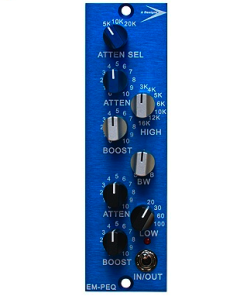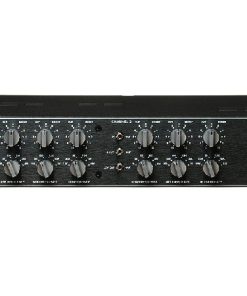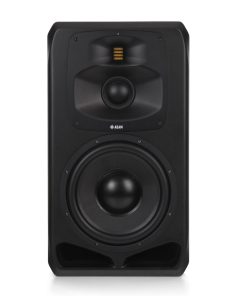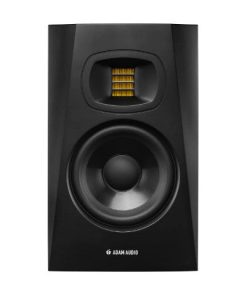SPL Channel One Mk3 SPL
$ 2.299,00 $ 574,75
The perfect front-end for the modern producer.
For over 20 years, Channel One has been a synonym for a high-quality and extremely musical recording and mixing channel strip.
In the newest Mk3 version, this classic has been thoroughly revised and, in addition to a higher internal audio voltage (now +/-18 V) for even better, more detailed sound, a further improved preamplifier section, an integrated Transient Designer, a Tube Saturation stage and a Mic A/B comparison option for two microphones and other great features that raise the modern recording and mixing studio to a new level of quality. With de-esser, compressor and equalizer, all the important tools of a real channel strip are still on board. Whether it’s a microphone, line, or instrument signal, the Channel One Mk3 makes any source sound like a professionally recorded signal.
The new design of the SPL Studio Series perfectly highlights the sonic qualities of this 3rd generation Channel One.
Discrete Preamplifier
Channel One Mk3 is equipped with a discrete preamplifier.
Gain
The gain control can be used to adjust the preamplification. For microphone signals, a preamplification of up to 68 dB can be realized – so even really demanding microphones can show their qualities. The control range for line signals ranges between -20 dB and +16 dB. The control range for instrument signals ranges between -6 dB and +30 dB.
Preamp Out – the direct way to reach your goal
The Preamp Out picks up the signal directly after the microphone amplifier. This signal can also be recorded on a separate track in the DAW, for example, to be on the safe side. If it is noticed after a recording session that the singer was a little louder in the perfect take and therefore hits the compressor too hard, this incorrect setting can still be changed afterwards. The signal recorded for safety can later be played back into the Channel One Mk3 via the Line In and be processed there with Tube Saturation, Compressor or other tools.
Analog plugin
Channel One Mk3 offers the possibility to process line signals. This means that sources with line level, such as an analog signal from an audio interface, can be processed with de-esser, compressor, limiter and equalizer and then be recorded again. In this way, Channel One Mk3 becomes an “analog plugin” within an insert of a DAW.
Instrument input
The low-noise instrument input is located easily accessible on the front.
PAD
The PAD switch attenuates the signal of the microphone input by 20 dB, so that even very high levels can be processed with the Channel One Mk3. This is the case, for example, with loud percussion or brass recordings.
ø
The phase reverse function reverses the polarity of the signal. After pressing the switch, the phase is reversed by 180°.
Tip:
We recommend checking the correct polarity before recording and correcting it if necessary. The phase inversion function can be used, for example, to correct a headphone monitor signal that may be out of phase. A voiceover artist, for example, hears himself through the headphones and simultaneously through the bones in his head. Phase inversion will cause an unnatural sound, and even minimal variations in distance to the microphone will cause drastic variations in the sound. Phase inversion can be applied to the microphone, line and instrument inputs. In general, you can always just try out whether a phase reverse has a positive effect on certain signals in the mix.
Highpass filter
A highpass filter with 6 dB per octave reduces impact noise below 80 Hz. This filter can be used for both preamplifiers.
Tube Saturation – magical tube sound
With this control the amount of tube saturation can be determined. The output level is accommodated automatically, in extreme settings the level increases by only 6 dB. Therefore decent to expressive harmonic distortions can be easily dialed in by turning just one knob.
Saturation effects are generated through the tube being pushed to and beyond its normal operating limits. In contrast to semiconductors, a tube thus pushed to such levels does not clip from a certain level, approaching more gradually its level limits and thereby producing its typical tonal result, which in audio signal processing can have such often profitable aural effects — on one hand (and depending on the amount applied), from subtle to extensive harmonic distortion and on the other hand, a compaction of the sonic event, that is, a limiting effect that exhibits a pleasant, rounded or soft sound. Acoustically and also in its range of applications this can be compared very well with tape saturation effects.
| Versions | Channel One Mk3, Channel One Mk3 Premium |
|---|
Prompt Delivery and Professional Packaging
Our long-standing partnership with UPS FedEx DHL and other global carriers lets us offer a range of shipping services. Our warehouse staff is extremely skilled and will package your items according to our precise and exact specifications. Your goods will undergo an extensive inspection and be safely packaged prior to being sent out. Each day, we ship to thousands of customers in many countries. The fact that we are committed to becoming the biggest online retailer in the World is clear. These warehouses are in Europe in the same way as they are in USA.
Note: Orders that include more than one item are assigned a processing period depending on the item.
Before shipping, we will inspect thoroughly the items you have ordered. Most orders are shipped within 48 hours. Expected delivery time is between 3-7 days.
Returns
Stock is dynamic. It's not entirely managed by us since we are involved with multiple entities, including the factory and the storage. The actual stock can change at any moment. It is possible that your order may be out of stock once the order has been placed.
Our policy lasts for 30 days. We cannot exchange or refund your order if it has been 30 days from the date of purchase.
For your item to be returned it must be in its original packaging, unopened and in the condition you received it. The item must be in its original packaging.
Related products
Microphones
Microphones
Recording Equipments
Microphones
Accessories
Microphones
Recording Equipments
Recording Equipments
Subwoofer
Mic Preamp
Equalizers
Accessories
Monitor Systems
Monitor Systems
Recording Equipments
Mic Preamp
Recording Equipments
500 Series
Monitor Systems
Recording Equipments
Accessories
Monitor
Monitor
Subwoofer
Monitor Systems
Equalizers

































































